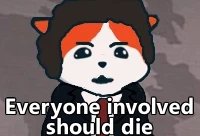You checked out my youtube channel? (If so then that's really cool). The reason why my upload schedule is like that its because it is said that the yt algorithm will try to push your channel if you upload at a frequent-ish rate (Or something like that). If you don't upload for a long time (Or maybe rarely at all) then the yt algorithm will punish you
Dude you don't understand i live in the goddarn philippines where they have this 'tuli culture' (Other filipino intactivists have also said about this)
Trying to waste my time huh, Okay i will give it to you. Tulì is a Filipino rite of male circumcision. It has a long historical tradition and is considered an obligatory rite of passage for males;[1] About 93 percent of Filipino males are circumcised.[1] Boys who have not undergone the ritual are labelled supót and face ridicule from their peers.[2]
Circumcision is not considered a religious rite as some four-fifths of Filipinos profess Roman Catholicism, which does not require it. Rather, circumcision is a social norm rooted in tradition that is followed by society at large. Most boys usually undergo the procedure not shortly after birth but prior to reaching puberty or before high school (around ages 10–14).
The Philippine Islands were once governed from India. The Sultanate of Maguindanao introduced Islam into Mindanao in the 15th century. Thereafter Islam spread through the Philippines. Circumcision (khitan) is a religiously founded tradition in Islam, so it was introduced into the Philippine culture.
Ferdinand Magellan claimed the Philippine Islands for Spain in 1521. Spain's control of the Philippines lasted until the Spanish-American war of 1898. Roman Catholicism was introduced into the Philippines during the Spanish rule. Christians recognized the harmful and abusive nature of circumcision at the Council at Jerusalem in 49 A. D. and rejected the practice as unnecessary for Christians. The Roman Catholic Church further repudiated the practice by the Bull of Union with the Copts in 1492.[3] Although in violation of Christian and Roman Catholic teachings, the Roman Catholic Church has turned a blind-eye to the practice of Tuli in the Philippine Islands, where it continues to flourish.
Tuli was introduced into the Philippine Islands hundreds of years ago, when the Islands were controlled by Muslims. Every since adult circumcised men have reenacted their own trauma on boys as reported by Vanderkolk.[4]
Boyle & Ramos (2019) studied boys in the Philippine Islands who had undergone medical circumcision and others who had suffered the traditional "tuli" circumcision. Of the boys who had a medical circumcision, 51 percent exhibited symptoms of PTSD. Of the boys who had a tuli circumcision, 69 percent exhibited symptoms of PTSD.[5] [6]
The Constitution of the Republic of the Philippines (1987) contains several provisions that may be violated by the practice of Tuli in the Philippines.[7]
Article XIII
Article XIII provides enactment of measures to advance social justice and human dignity. Section 11 provides for the advancement of health. Section 17 provides for a Commission on Human Rights. Section 18 provides specific powers to the Commission to investigate human rights violations and to "[p]rovide appropriate legal measures for the protection of human rights of all persons within the Philippines."[7] No such measures seem to have been enacted to protect boys from Tuli.
Article XV
Article XV provides protection for the family. Section 3(2) provides the right of children to "special protection from all forms of neglect, abuse, cruelty, exploitation, and other conditions prejudicial to their development".[7]
It appears that no one in the Philippine Republic has thought it appropriate to apply these constitutional provisions to the practice of Tuli, except perhaps for Ramos & Boyle, who briefly called for the application of human rights to Tuli.[6]
Jump in the discussion.
No email address required.
is this a bit or are you schizo?
Jump in the discussion.
No email address required.
What do you mean?
Jump in the discussion.
No email address required.
It appears you upload pc speaker music videos but like daily?
That's kind of cool but also pretty !schizos
Jump in the discussion.
No email address required.
You checked out my youtube channel? (If so then that's really cool). The reason why my upload schedule is like that its because it is said that the yt algorithm will try to push your channel if you upload at a frequent-ish rate (Or something like that). If you don't upload for a long time (Or maybe rarely at all) then the yt algorithm will punish you
Jump in the discussion.
No email address required.
More options
Context
yeah I'm tired of pings for MS-DOS videos
Jump in the discussion.
No email address required.
I also have [PC Booter] videos as well
Jump in the discussion.
No email address required.
More options
Context
More options
Context
its an extremely neurodivergent child
child  that has like 100 posts seething
that has like 100 posts seething  about being circumcised lol
about being circumcised lol
Jump in the discussion.
No email address required.
Dude you don't understand i live in the goddarn philippines where they have this 'tuli culture' (Other filipino intactivists have also said about this)
Jump in the discussion.
No email address required.
please explain the tuli culture. is this a culture where
explain the tuli culture. is this a culture where  everyone
everyone  seethes about being circumcised?
seethes about being circumcised?
Jump in the discussion.
No email address required.
https://old.reddit.com/r/Intactivists/comments/yskj4m/stop_tulì_a_new_subreddit_for_intactivist/ & https://old.reddit.com/r/Intactivism/comments/16qrwwu/why_tulì_is_bad/
Jump in the discussion.
No email address required.
i asked YOU to explain it
YOU to explain it
not for a bunch of links
Jump in the discussion.
No email address required.
Trying to waste my time huh, Okay i will give it to you. Tulì is a Filipino rite of male circumcision. It has a long historical tradition and is considered an obligatory rite of passage for males;[1] About 93 percent of Filipino males are circumcised.[1] Boys who have not undergone the ritual are labelled supót and face ridicule from their peers.[2]
Circumcision is not considered a religious rite as some four-fifths of Filipinos profess Roman Catholicism, which does not require it. Rather, circumcision is a social norm rooted in tradition that is followed by society at large. Most boys usually undergo the procedure not shortly after birth but prior to reaching puberty or before high school (around ages 10–14).
The Philippine Islands were once governed from India. The Sultanate of Maguindanao introduced Islam into Mindanao in the 15th century. Thereafter Islam spread through the Philippines. Circumcision (khitan) is a religiously founded tradition in Islam, so it was introduced into the Philippine culture.
Ferdinand Magellan claimed the Philippine Islands for Spain in 1521. Spain's control of the Philippines lasted until the Spanish-American war of 1898. Roman Catholicism was introduced into the Philippines during the Spanish rule. Christians recognized the harmful and abusive nature of circumcision at the Council at Jerusalem in 49 A. D. and rejected the practice as unnecessary for Christians. The Roman Catholic Church further repudiated the practice by the Bull of Union with the Copts in 1492.[3] Although in violation of Christian and Roman Catholic teachings, the Roman Catholic Church has turned a blind-eye to the practice of Tuli in the Philippine Islands, where it continues to flourish.
Tuli was introduced into the Philippine Islands hundreds of years ago, when the Islands were controlled by Muslims. Every since adult circumcised men have reenacted their own trauma on boys as reported by Vanderkolk.[4]
Boyle & Ramos (2019) studied boys in the Philippine Islands who had undergone medical circumcision and others who had suffered the traditional "tuli" circumcision. Of the boys who had a medical circumcision, 51 percent exhibited symptoms of PTSD. Of the boys who had a tuli circumcision, 69 percent exhibited symptoms of PTSD.[5] [6]
The Constitution of the Republic of the Philippines (1987) contains several provisions that may be violated by the practice of Tuli in the Philippines.[7]
Article XIII
Article XIII provides enactment of measures to advance social justice and human dignity. Section 11 provides for the advancement of health. Section 17 provides for a Commission on Human Rights. Section 18 provides specific powers to the Commission to investigate human rights violations and to "[p]rovide appropriate legal measures for the protection of human rights of all persons within the Philippines."[7] No such measures seem to have been enacted to protect boys from Tuli.
Article XV
Article XV provides protection for the family. Section 3(2) provides the right of children to "special protection from all forms of neglect, abuse, cruelty, exploitation, and other conditions prejudicial to their development".[7]
It appears that no one in the Philippine Republic has thought it appropriate to apply these constitutional provisions to the practice of Tuli, except perhaps for Ramos & Boyle, who briefly called for the application of human rights to Tuli.[6]
(Source of reused words: IntactWiki)
Jump in the discussion.
No email address required.
More options
Context
More options
Context
More options
Context
More options
Context
More options
Context
More options
Context
More options
Context
More options
Context
More options
Context